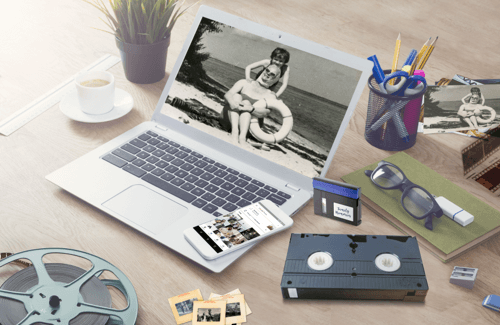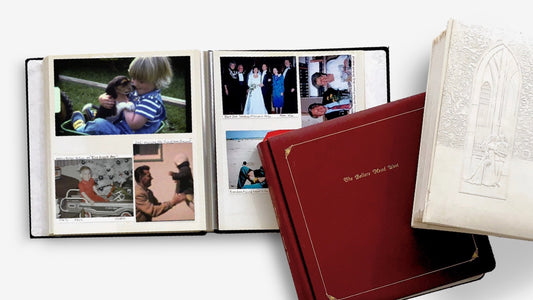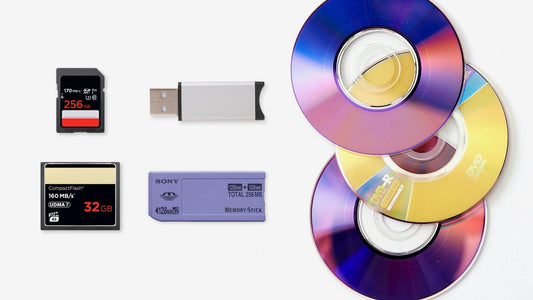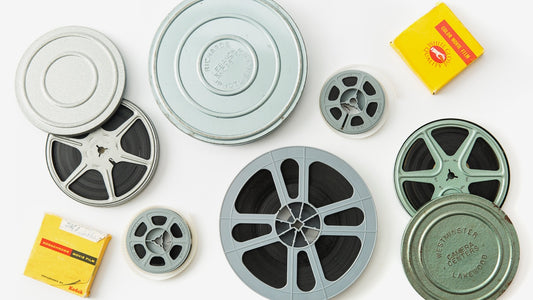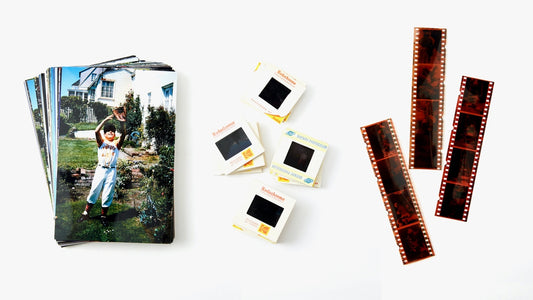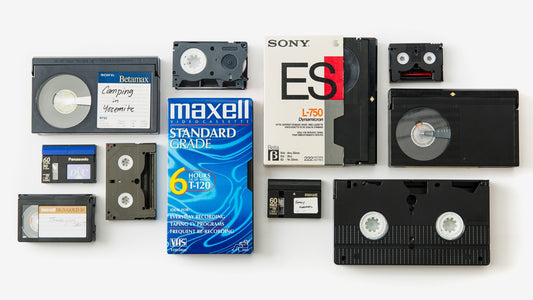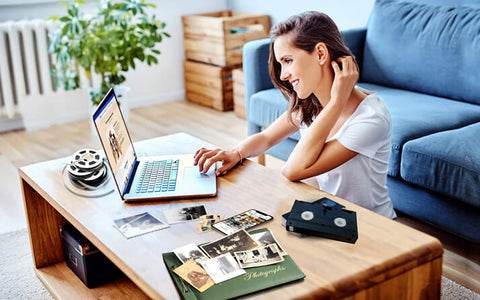What if your children could hear the voice of a great-grandparent they never met? The audio captured on old reel-to-reel tapes is a powerful link to your family’s past, holding the sounds and stories that make up your legacy. But those memories are trapped on a format that’s becoming more fragile every year. A reel-to-reel tape digital conversion is about more than just technology; it’s about connection. It makes those voices and moments an active part of your life again. This guide shows you how to safely preserve that audio history, ensuring it can be shared by your entire family.
Key Takeaways
- Preserve Your Tapes Before They Fade: Reel-to-reel tapes degrade over time, putting your audio memories at risk. Converting them to digital files is the best way to create a permanent, shareable archive of your family's history, protecting it from physical decay.
- Choose Your Path: Professional Service or DIY: A professional service offers peace of mind and expert handling for your irreplaceable tapes. The DIY route gives you full control but requires the right equipment and technical know-how, along with the risk of damaging fragile media.
- Understand the Final Product: A digital conversion faithfully copies your original tape, including any existing background noise. For the final files, choose a format that fits your goals—MP3s are ideal for easy sharing, while uncompressed formats like WAV are best for long-term, high-quality archiving.
What Does It Mean to Digitize Reel-to-Reel Tapes?
If you’ve stumbled upon a box of old reel-to-reel tapes in your attic, you’ve found some serious audio treasures. Reel-to-reel tape conversion is simply the process of taking the audio from those analog reels and turning it into digital files, like MP3s. This means you can listen to those precious recordings on your computer, phone, or any modern device, and easily share them with your family. It’s about bringing your family’s sound history into the present day.
First Things First: What Are Reel-to-Reel Tapes?
Think of reel-to-reel tapes as the high-fidelity predecessor to the cassette tape. Before digital audio and even before compact cassettes became common, these large reels of magnetic tape were the go-to for capturing high-quality sound. They were used by everyone from professional musicians in recording studios to families documenting special occasions at home. Because the tape is wider and moves faster than a cassette, the sound quality is often incredibly rich and detailed. These magnetic tape recordings were the standard for decades, which is why so many important audio memories are stored on them, just waiting to be heard again.
How Reel-to-Reel Technology Works
The mechanics of a reel-to-reel player are hands-on and a bit more involved than popping in a cassette. The system, also called open-reel recording, uses magnetic tape that is spooled between two separate reels. To play a tape, you have to manually pull the end of the tape from the supply reel, thread it through a series of guides and across a "tape head," and then attach it to an empty takeup reel. The tape head is the crucial component that reads the magnetic information on the tape to reproduce the sound. This manual process is part of what makes the format so distinct and why handling these tapes requires a gentle, steady hand.
Recording Sound on Magnetic Tape
The magic of reel-to-reel lies in how it captures sound on what is essentially a long ribbon of plastic. This tape is coated with tiny, magnetizable metal particles. When you record, an electrical signal from a microphone travels to the "recording head," which creates a magnetic field. As the tape passes over the head, this field arranges the metal particles into specific patterns that mirror the sound waves. During playback, the process reverses: the tape head reads these magnetic patterns and converts them back into an electrical signal, which is then sent to speakers as the sound you hear. It’s a physical imprint of a moment in time, capturing voices and music in magnetic form.
The Role of Tape Speed in Audio Quality
If you've ever heard people praise the sound of reel-to-reel, tape speed is a big reason why. Generally, the faster the tape moves across the heads, the better the audio quality. Think of it like drawing a picture on a bigger canvas—a faster speed spreads the audio signal over a longer section of tape. This provides more detail and significantly reduces background hiss, a common issue with analog formats. It also improves the reproduction of high-frequency sounds, making music sound crisper and voices clearer. This is why professional studios used high tape speeds, and it’s a key factor in the rich quality of many old family recordings.
Other Factors That Influence Sound
While speed is important, it’s not the only thing that determines how a tape sounds. The width of the tracks on the tape also plays a part; wider tracks generally produce a stronger, cleaner signal. The specific chemical makeup of the magnetic coating on the tape and the overall quality of the recorder itself are also critical. A high-end machine with well-designed heads and a motor that maintains a perfectly steady speed will always produce better sound. Because these variables can greatly affect the final audio, using professional, well-maintained equipment is the best way to ensure you preserve your audio memories with the highest possible fidelity, capturing every detail just as you remember it.
Don't Let Your Audio Memories Fade Away
Those reels hold more than just magnetic tape; they hold moments. It might be the only recording of your grandfather’s voice telling a story, the sounds of a family wedding from 50 years ago, or your mom singing a lullaby. Over time, these tapes degrade. The magnetic signal can fade, and the tape itself can become brittle and warped, putting those memories at risk of being lost forever. By converting them to digital, you’re not just making a copy. You’re building a permanent archive of your family’s legacy that won’t decay. It’s a way to preserve and share your cherished memories for generations to come.
From Analog Tape to Digital File: How It Works
You might think converting old tapes is a complicated technical process, but professional services make it incredibly simple. Typically, you’ll start by ordering a kit that comes with a crush-proof box and a prepaid shipping label. You just pack your tapes, apply the provided barcodes to keep everything organized, and send them off. Once they arrive at the lab, trained technicians carefully handle each reel by hand. They use professional-grade equipment to capture the best possible audio from your tapes. This process is similar to our film transfer service, where every step is designed to protect your originals while creating a high-quality digital copy you’ll love.
The History and Cultural Impact of Reel-to-Reel
Beyond the priceless family recordings of birthdays and holidays, reel-to-reel tapes hold a fascinating place in history. This format wasn’t just a tool for capturing memories at home; it was the technology that powered a revolution in the music industry. For decades, it was the gold standard for professional recording, used by legendary artists and producers to create the albums that became the soundtrack to our lives. Understanding the history of these tapes adds another layer of appreciation for the audio they contain. The same technology that captured your grandmother’s laugh was also used by musical pioneers to experiment with sound in ways no one had ever imagined. It’s a format that truly shaped modern audio, making the quest to preserve it all the more meaningful.
A Timeline of Analog Dominance
Long before we carried entire music libraries in our pockets, reel-to-reel tape set the standard for high-fidelity audio. For decades, it was the go-to format before the compact cassette arrived, known for its superior quality. Also called open-reel recording, it involved threading a spool of magnetic tape between two reels in a hands-on process that felt significant. While cassettes offered convenience, reel-to-reel delivered a richer sound, making it the preferred choice for serious audiophiles and professional recording studios. This was the era of analog, where sound was a physical thing, captured on a tangible medium you could see and touch.
Key Innovations That Shaped Audio
The design of reel-to-reel tape is what set it apart. The magnetic tape was wider and moved across the recording heads at a much faster speed than a cassette tape, allowing for a more detailed and accurate sound capture. This superior quality wasn't the only breakthrough. Companies like Ampex introduced stereo and multitrack recorders, which completely changed how music was made. Suddenly, artists could record different instruments and vocals separately and layer them together. The legendary guitarist Les Paul was an early adopter, using an Ampex eight-track machine to pioneer new recording techniques that would influence countless musicians for generations to come.
How Tape Recording Changed Music Forever
The introduction of reel-to-reel technology did more than just improve sound quality; it fundamentally changed the creative process of making music. For the first time, sound became something artists and engineers could physically manipulate. The tape wasn't just a medium for capturing a live performance—it became an instrument in its own right. Musicians began to see the recording studio as a creative playground where they could experiment, edit, and construct sounds that were impossible to create live. This shift marked the beginning of modern music production, where the recording itself is as much a part of the art as the song itself.
The Art of Tape Manipulation
This new creative freedom sparked incredible creativity. Artists would physically cut the magnetic tape with a razor blade and splice different pieces together to create unique arrangements or edit out mistakes. They discovered they could change the pitch and tempo of a recording by speeding up or slowing down the tape reels. Some even played the tape backward to create psychedelic and otherworldly sounds. This hands-on, artistic approach was the original form of sampling and remixing. It required incredible precision and a creative vision, turning audio engineering into a true craft and shaping the sound of iconic albums from bands like The Beatles and Pink Floyd.
Lasting Influence on Modern Music
Even with all the digital tools available today, the sound of analog tape is still highly sought after. The subtle imperfections of reel-to-reel—like gentle compression and a distinct "warmth"—are now seen as desirable qualities that add character and cohesiveness to a track. In fact, many modern digital recording programs include special effects designed to mimic the sound of tape saturation and echo. The legacy of this format is a testament to its unique audio quality. When you preserve the sound from your family’s old reels, you’re saving a piece of audio history in its most authentic form. It’s the same principle behind preserving any kind of old media, like when you transfer video tapes to create a lasting digital archive.
Why Should You Convert Reel-to-Reel Tapes to Digital?
Those old reel-to-reel tapes are probably tucked away somewhere safe, holding priceless audio memories like a grandparent’s story or the sounds of a family wedding. While keeping the original tapes feels important, they are unfortunately living on borrowed time. Converting them to a digital format is the single best step you can take to protect those sounds and make them a part of your life again. It’s about transforming a fragile artifact into a lasting family treasure that you can listen to and share anytime.
What You Gain by Going Digital
The biggest advantage of going digital is simple: access. Instead of needing a bulky, decades-old player, you can listen to your audio recordings on your phone, computer, or smart speaker with a simple click. Digital files are also incredibly durable. Unlike magnetic tape, they don’t degrade over time, meaning the audio will sound just as clear decades from now. This makes it easy to create backups and share copies with the entire family, no matter where they live. A digital media transfer turns a dusty box in the attic into a playlist of cherished moments, ready to be enjoyed all over again.
Why Your Analog Tapes Are at Risk
Analog tapes are vulnerable to the passage of time. The magnetic coating that holds the audio can break down in a process called "sticky shed syndrome," leaving you with a gummy, unplayable mess. Tapes are also susceptible to mold and mildew from humidity, which can permanently damage them. Even finding a working reel-to-reel player is a challenge, and a faulty machine can easily stretch or snap a delicate tape. Every year that passes increases the risk of losing these one-of-a-kind recordings forever. Preserving them is similar to the care required for old home movies, which also face degradation, making a film transfer a crucial step for preservation.
Understanding "Print-Through" and Other Tape Flaws
Even if your tapes have been stored carefully, they can develop issues just from sitting on the shelf. One of the most common is called print-through, a strange phenomenon where the magnetic signal from one layer of tape "bleeds" onto the layer next to it on the reel. This creates faint, ghostly echoes of the audio that you can hear just before or after the actual sound. Unfortunately, once it happens, this echo is a permanent part of the recording and can’t be removed. Beyond print-through, tapes can also suffer from physical damage like scratches, dirt, or becoming brittle with age. These flaws highlight why it's so important to handle these delicate reels with care and digitize them before the audio quality degrades any further.
Making Your Audio Memories Last a Lifetime
Converting your reel-to-reel tapes is about more than just preservation; it’s about bringing your family’s history to life. Imagine easily playing the audio from a wedding toast for an anniversary or letting your kids hear the voice of a great-grandparent they never met. When you use a professional service, you can trust that your irreplaceable tapes are handled carefully by experts. They know how to manage fragile media and capture the best possible audio quality. This process ensures that the sounds of your family’s past aren’t lost, but are instead preserved as a beautiful, listenable legacy for future generations to discover and enjoy.
The Modern Reel-to-Reel Revival
While you might see that stack of reel-to-reel tapes as a purely personal time capsule, the format itself is having a major moment. It’s not just about nostalgia; there’s a growing community of audiophiles and professional musicians who are turning back to magnetic tape as the ultimate way to experience and create sound. This modern revival is driven by a quest for unparalleled audio quality that many believe digital formats simply can’t replicate. It’s a testament to the incredible technology behind those reels you have stored away, waiting to be heard again.
Understanding this resurgence helps put the value of your own tapes into perspective. The same characteristics that make reel-to-reel the top choice for high-end audio enthusiasts are what make your family recordings so rich and full of life. The warmth, the depth, and the incredible detail captured on that magnetic tape are what make those voices and sounds feel so present, even decades later. It’s a powerful reminder that what you’re preserving isn’t just a recording; it’s a high-fidelity snapshot of a moment in time, captured on a medium that is now celebrated for its superior quality.
Reel-to-Reel vs. Vinyl: The Audiophile Debate
For many, vinyl records represent the peak of analog sound, but for serious audiophiles, the conversation often ends with reel-to-reel. The simple reason is that magnetic tape can hold more sonic information. Experts argue that tape offers better sound quality because it captures a much wider dynamic range—the difference between the softest and loudest sounds in a recording. This means you can hear the subtle nuances, like the quiet intake of breath before someone speaks or the gentle rustle of a wedding dress, with a clarity that vinyl can sometimes miss. It creates a listening experience that feels more immersive and true to life.
Why Modern Artists Still Choose Analog Tape
It’s not just listeners who are rediscovering reel-to-reel; many modern artists are actively choosing to record on analog tape. Musicians like Jack White, Beck, and The Black Keys have used it to capture a sound they describe as more "warm and natural." Unlike the crisp perfection of digital recording, analog tape has a way of capturing a performance with a certain character and soul that feels more authentic and human. This trend shows that reel-to-reel is far from obsolete. In fact, its unique ability to capture a real feeling has cemented its place as a respected and relevant tool in the modern music world.
Professional Service vs. DIY: Which Is Right for You?
Deciding how to convert your reel-to-reel tapes is a big step. Should you hand them over to a team of experts or tackle the project yourself? There’s no single right answer—it really comes down to your comfort level with technology, how much time you have, and how precious these audio recordings are to you. Let's walk through both options so you can feel confident in your choice.
Why a professional service
If your tapes contain one-of-a-kind family memories, using a professional service offers peace of mind. When you choose a digitization service, you’re not just paying for the final files; you’re paying for expertise. Professionals use high-quality, calibrated equipment to capture the best possible sound, carefully monitoring the process from start to finish. For many, the biggest benefit is knowing their irreplaceable tapes are in safe hands. Companies that specialize in media transfer have teams who handle these delicate formats every day, ensuring your memories are treated with care. This is the most straightforward path to getting high-quality digital audio files you can easily share and enjoy on any modern device.
Tackling It Yourself: Your DIY Checklist
If you’re a hands-on person who enjoys a good project, a DIY conversion can be a rewarding experience. Before you start, you’ll need to gather some specific gear. The biggest hurdle is finding a working reel-to-reel tape deck that runs at the correct speed for your tapes. You'll also need the right adapters to connect the deck to your computer, like an RCA to 1/8-inch cable. For the recording itself, a free and powerful program like Audacity is a fantastic tool for capturing and editing the audio. This route requires patience and a bit of technical know-how, but it gives you complete control over the entire process from start to finish.
Avoid These Common DIY Conversion Mistakes
Digitizing tapes yourself can have a few pitfalls. Old tapes can be fragile and may suffer from issues like mold or "sticky shed syndrome," where the magnetic coating flakes off, potentially damaging both the tape and your player. To get clear audio, you have to be diligent about cleaning the tape heads on your deck. Some online guides suggest "baking" tapes that have sticky shed syndrome, but this is a risky procedure that can permanently damage the tape if done incorrectly. If your tapes are showing signs of decay, it’s often safer to trust a professional service that has experience with restoring and handling fragile media.
Comparing the Best Reel-to-Reel to Digital Services
Choosing a professional service to handle your precious memories can feel like a big decision. You want a company you can trust to treat your tapes with care and deliver a high-quality digital copy you can enjoy for years. The good news is that there are several excellent services out there, each with its own strengths. Whether you prioritize a simple process, specialized audio care, or a one-stop shop for various media types, there’s a service that fits your needs. Let’s walk through some of the top options so you can find the perfect match for your reel-to-reel project.
YesVideo
If your reel-to-reel tapes are part of a larger collection of home movies, YesVideo is a fantastic choice. With over 20 years of experience, they are the largest and most trusted digitization service, handling every order by hand right here in the USA. They offer comprehensive video transfer services that cover a wide range of formats, so you can send in your film reels, videotapes, and photos along with your audio tapes. This makes it incredibly convenient to digitize your entire family archive in one go. Customers appreciate the quality of the digital files and how easy it is to access and share their memories online. As with any service, it’s always smart to check recent customer feedback before sending in your media.
Southtree
Southtree is known for its simple, user-friendly process. If you’re looking for a straightforward experience without a lot of fuss, this is a great option. They send you a box, you fill it with your reel-to-reel tapes and other media, and they handle the rest. Their service is well-reviewed for its reliability and solid customer support, which provides peace of mind when you’re sending off irreplaceable memories. Southtree makes the entire digitization journey feel manageable and secure, returning your original tapes along with your new digital copies. It’s a dependable choice for getting the job done efficiently and effectively.
Audio Conservation
For those whose primary focus is on getting the absolute best audio quality from their reel-to-reel tapes, Audio Conservation is a standout. As their name suggests, this company specializes in preserving audio formats. They bring a level of expertise and personalized service that’s ideal for tapes that might contain music, important family conversations, or other audio you want to preserve with the highest fidelity. They focus on maintaining the unique characteristics of each recording, ensuring the digital version is a true and clear representation of the original. If your project is all about the sound, their specialized approach is hard to beat.
EverPresent
EverPresent is another company that offers comprehensive digitization services, and they are particularly known for their high-quality results and attention to detail. They are a great fit if you’re looking for a premium experience and are willing to invest a bit more for meticulous handling of your media. Their process is thorough, and they place a strong emphasis on customer satisfaction, walking you through the options to ensure the final product meets your expectations. For delicate or especially cherished reel-to-reel tapes, the extra care and detailed work from EverPresent can provide valuable peace of mind and an exceptional final product.
Legacybox
You’ve likely seen Legacybox advertised, and for good reason. They offer a very convenient service designed to be as easy as possible for the customer. Much like Southtree, they operate on a mail-in kit system. You receive a crush-proof box, fill it with your reel-to-reel tapes and any other media you want to convert, and ship it off. This system is perfect for anyone who feels a little overwhelmed by technology and just wants a simple, all-in-one solution. Legacybox has made a name for itself by making media conversion accessible to everyone, regardless of their tech-savviness, and they guide you through every step of the process.
From Your Hands to Ours: The Conversion Process Explained
Sending your precious reel-to-reel tapes to be digitized can feel like a leap of faith. You’re handing over one-of-a-kind memories, and it’s natural to wonder what happens next. The good news is that professional conversion is a well-established process designed to protect and preserve your audio. Understanding the journey your tapes take, from the moment they leave your hands to their return as digital files, can give you confidence and peace of mind. Here’s a look at what you can expect.
How to Prep Your Tapes for a Smooth Conversion
Before you pack up your tapes, it’s a good idea to give them a quick visual inspection. You don’t need to be an expert, but look for any obvious signs of damage, like a cracked reel or visible mold on the tape itself. Some older tapes suffer from a condition called "sticky shed syndrome," where the magnetic coating starts to flake off. Professionals can often treat this with a special baking process, but it’s a delicate procedure best left to the experts. Your main job is to handle them carefully and pack them securely for their journey. A professional film transfer service has seen it all and is equipped to handle the unique challenges of older media.
Behind the Scenes: The Professional Digitization Process
Once your tapes arrive at the lab, the real magic begins. At a trusted service like YesVideo, every order is processed by hand by trained technicians right here in the USA. They don’t just press play on a machine and walk away. Instead, they use high-quality, specialized equipment to carefully monitor the entire transfer. This hands-on approach ensures the best possible audio quality is captured from your original recording. You can also expect to receive email updates at each step of the process, from when your tapes arrive to when your new digital files are ready, so you’re never left guessing where your memories are.
The "Tape Baking" Process for Sticky-Shed Syndrome
Over the years, the binder that holds the magnetic particles to the plastic base of a tape can absorb moisture from the air, causing it to become gummy. This is known as "sticky-shed syndrome," and it can make a tape unplayable, potentially damaging it and the playback machine. To fix this, professionals use a highly controlled process called "tape baking." The tape is placed in a special oven at a low, stable temperature for several hours—sometimes more than eight—to gently remove the absorbed moisture and temporarily restore the tape so it can be played safely for transfer. This is a delicate, expert-level procedure that should never be attempted at home, as improper heating can destroy a tape permanently. It’s a perfect example of why trusting a professional service is so important for fragile media.
How Tracks Are Handled in Conversion
It’s helpful to know what to expect from your final digital files. Professional conversion services don’t separate individual songs or distinct conversations into separate tracks. Instead, they create a faithful digital copy of your original media. This means that each side of your reel-to-reel tape will be converted into one continuous digital audio file. If a tape has 30 minutes of audio on one side, you’ll receive a single 30-minute MP3 or WAV file for that side. This approach preserves the original listening experience exactly as it was recorded. If you want to split the audio into smaller clips later, you can easily do so with free audio editing software on your computer.
Optional Services: Expedited Processing and Digital Backups
Most digitization services offer a few options for how you receive your newly digitized memories. The most common choice is a secure cloud download, which gives you instant access to your files and makes sharing with family members as easy as sending a link. For a physical copy, you can typically opt for a USB drive, which is a great way to have a tangible backup of your audio history. Some services also offer CDs. At YesVideo, we provide both a private online account for viewing and sharing, plus the option to get your memories on a USB. If you're on a tight deadline for a gift or event, many companies also offer expedited processing to move your order to the front of the line.
Can Damaged Tapes Still Be Saved?
It’s important to have realistic expectations about the final quality. If your original recording had background noise, low volume, or other imperfections, those will likely be present in the digital copy. Think of it as a faithful transfer, not a complete makeover. Technicians will first inspect your tapes for any severe damage that might prevent a transfer. For issues like hiss, hum, or crackles, some services offer advanced audio restoration as a separate, add-on service. Because every tape is different, this is usually quoted after the initial video transfer is complete, allowing experts to assess exactly what’s needed to improve the sound.
What Professional Services Can (and Can't) Repair
When you hand over your tapes, you're also getting an expert eye on their condition. Professionals can tackle many common audio problems, like tape hiss, electrical hum, and inconsistent volume levels, making the final recording much easier to listen to. They can also handle minor physical issues. If a tape has snapped or has an old splice that's come apart, technicians can often repair it before the transfer. For tapes suffering from "sticky shed syndrome"—a common issue where the tape's coating gets gummy—experts can use a special "baking" process to make it playable. This is a delicate procedure that's best left to a service that has experience handling fragile media by hand.
It’s also helpful to know the limits of a standard transfer. A digitization service creates a faithful copy of your original tape, which means it captures everything—including any background noise or imperfections from the original recording. If the audio was muffled to begin with, the digital version will be too. While some services offer advanced audio restoration as an add-on, this is usually quoted separately after they can assess the tape's specific needs. And in some rare cases, a tape might be too damaged to save, for instance, if it's completely blank or has severe mold damage. A trustworthy service will always inspect your media first and let you know if a tape is unsalvageable.
How to Choose the Right Digital Audio Format
Once your reel-to-reel tapes are digitized, you’ll get your audio back as a digital file. But which file type is best? The format you choose affects everything from sound quality to file size, so it’s helpful to understand your options. Think of it as deciding whether you want a full-size, high-resolution photo for framing or a smaller version that’s easy to text to a friend. Both are great, but they serve different purposes. Making the right choice ensures your precious audio memories are preserved perfectly for how you plan to use them.
WAV vs. MP3 vs. FLAC: What's the Difference in audio file formats (WAV, MP3, FLAC)
Don't worry, this is much simpler than it sounds. You'll likely encounter three main audio formats: WAV, MP3, and FLAC. Think of a WAV file as the digital master copy. It’s an uncompressed format, meaning it captures the full, original sound from your tapes without losing a single detail. This makes WAV the top choice for professional archiving. The only downside is that the files are very large.
MP3 is the format you’re probably most familiar with. It makes files much smaller by removing bits of sound data our ears don't easily notice. This makes it the most convenient and widely used audio file format for phones and sharing online. FLAC is a great middle-ground option that shrinks file size without tossing out any audio data, giving you full quality in a smaller package.
Audio Quality vs. File Size: Finding the Sweet Spot
Your choice really comes down to how you plan to use your newly digitized audio. There’s a direct trade-off between quality and file size, so it’s about finding the right balance for your needs. If your main goal is to create a perfect archival copy that you can store safely for decades, the large file size of a WAV is a worthwhile investment in quality. Think of it as your family’s audio time capsule. On the other hand, if you’re excited to load those family recordings onto your phone or share them easily with relatives, the convenience and smaller size of an MP3 make it the ideal choice. Most professional digital media transfer services will provide a standard, high-quality format that works for most people.
How to Ensure Your Files Play on Any Device
What good is a digital file if you can’t play it? Compatibility is a key factor to consider, especially when you plan on sharing your memories. The hands-down winner for universal playback is the MP3. It’s supported by virtually every device imaginable—from computers and smartphones to smart TVs and car stereos. It’s the safest bet for ensuring everyone in the family can listen without any technical hiccups. While WAV and FLAC files offer higher fidelity, they aren’t as universally supported on all devices, though most modern computers handle them just fine. When you receive your digital files, choosing a widely recognized audio quality format ensures your memories are not just preserved, but also accessible and easy to enjoy for years to come.
How Much Does Reel-to-Reel Conversion Cost?
When you’re ready to digitize your audio tapes, one of the first questions is usually about cost. The good news is that there are options for different budgets. The final price tag depends on the service you choose, the condition of your tapes, and any extra features you might want. Let's walk through what you can expect so you can plan accordingly.
Breaking Down the Cost of Conversion
Prices can vary quite a bit from one service to another, so it helps to know the typical range. You’ll find that some companies charge a flat fee per tape, which can be as low as $15 per reel. Other services might have a higher base price, sometimes closer to $45 per tape, depending on the specifics of their process and the technology they use. It’s a good idea to compare a few options to see what’s included in that initial price before you send your memories off. This helps ensure there are no surprises and you get the quality you're looking for.
What Factors Determine the Final Cost?
The price you see advertised is often just a starting point. A few key factors can affect your final bill, with the most common one being the condition of your tapes. If a reel is brittle, warped, or has other damage, it might require special repairs before it can be safely played and converted. This is similar to how the condition of old film reels can impact the film transfer process. Another factor is the tape’s original recording speed, as different speeds can require more time or specialized equipment. A trustworthy service will always inspect your tapes first and let you know if any extra work is needed.
Are Add-On Services Worth the Price?
Beyond the basic conversion, you’ll have a few choices that can add to the cost. For instance, if your audio has a lot of background hiss or hum, you might opt for audio restoration services to clean it up. You also need to decide how you want to receive your new digital files. Most companies offer several options for your digital media transfer, like a physical USB drive, a disc, or access to your files through a secure cloud service. These add-ons give you the flexibility to get your memories back in the format that works best for you and your family.
Tips for a High-Quality Reel-to-Reel to Digital Transfer
When you decide to digitize your reel-to-reel tapes, the goal is to get the best possible sound from your original recordings. The final quality of your digital audio files depends heavily on the condition of the original tapes and the equipment used for the transfer. A professional service uses high-end decks to capture the most accurate sound possible. Understanding a few key concepts, like audio restoration and what to expect from the original recording, will help you know what a high-quality conversion looks like.
What Is Audio Restoration and Do You Need It?
You might notice that some of your old tapes have a bit of a hiss, hum, or other background noise. Audio restoration is the process of fixing these kinds of sound issues. Think of it as a special treatment to clean up the sound after the initial transfer is complete. Most conversion services offer this as an add-on because every tape is unique and requires a different amount of work. If you’re interested in this, the service will typically provide a custom quote after they’ve assessed your tape’s specific needs. It’s a great option if you have a particularly precious recording that could use a little extra polish to sound its best.
Noise Reduction Systems like Dolby and DBX
When you look at your old reel-to-reel tapes, you might spot a logo for Dolby or DBX printed on the box. These are special noise reduction systems that were used to record cleaner, crisper audio by minimizing the background hiss common to analog tape. These systems work by encoding the sound during recording, which means they need a corresponding decoding process during playback to sound correct. If a tape recorded with Dolby is played back without it, the audio can sound overly bright and thin. This is why it’s important that the equipment used for your digital media transfer can properly handle these formats.
Dolby, a system widely used in professional studios, works by compressing the audio signal during recording and then expanding it during playback, which effectively reduces unwanted noise. On the other hand, DBX systems used a different approach to achieve a similar goal, often praised for creating a very clear sound with an impressive dynamic range. Both were designed to deliver a higher-fidelity listening experience, and a professional service will know how to properly decode them to ensure the digital version of your audio sounds exactly as it was intended.
How to Preserve the Authentic Sound of Your Tapes
It’s important to remember that digital conversion creates a faithful copy of your original tape. If the original recording had some quirks—like muffled sound, background chatter, or moments where the volume was too low—those will be present in the digital version, too. A professional video transfer service can’t remove background noise that was part of the original recording itself. The aim is to preserve the recording exactly as it was, capturing its authentic character, flaws and all. Setting realistic expectations is key; the new digital file will be a mirror image of your tape, not a completely remastered version unless you specifically request restoration services.
How to Listen for Quality in Your New Digital Files
Once you receive your digital audio files, take a moment to listen to them carefully. The quality of the original tape brand and the professional-grade equipment used for the transfer both play a big role in the final sound. For the best listening experience, use a good pair of headphones or speakers. Listen for clarity and make sure there aren't any new digital noises, like clicks or pops, that weren't on the original tape. The sound should be consistent and clear. A high-quality conversion will sound just like your original tape, but in a durable, easy-to-share format that you can enjoy for years to come.
Related Articles
- The Ultimate Guide to Convert Tapes to Digital – YesVideo
- How to Convert Cassette to Digital: A Guide – YesVideo
- Cassette to Digital: Your Ultimate Conversion Guide – YesVideo
- How to Digitize Cassette Tapes: A Simple Guide – YesVideo
- Video Tape to Digital: DIY or Pro? Your Best Bet – YesVideo
Frequently Asked Questions
What happens to my original tapes after they're converted? Do I get them back? Absolutely. Any reputable service understands that your original tapes are irreplaceable family treasures. After the technicians carefully create your new digital files, your original reel-to-reel tapes will be securely packed and sent back to you along with your digital copies. The goal is to give you a modern, durable version of your memories while ensuring your originals return home safely.
How long does the entire conversion process usually take? The timeline can vary depending on the service you choose and how many orders they're processing, but you can generally expect it to take a few weeks from the time you ship your tapes. A professional service will keep you informed throughout the journey. You’ll typically receive email updates when your box arrives at their facility, during the digitization process, and when your order ships back to you, so you’re never left wondering.
Does it matter how much audio is on each reel? Is the price the same for a full tape versus a short one? For the sake of simplicity, most professional services charge a flat rate per tape, regardless of how much audio is actually recorded on it. This means you don't have to worry about whether a reel contains ten minutes or two hours of audio. The price covers the careful handling, inspection, and digitization of the entire reel to ensure nothing is missed.
I have a mix of reel-to-reel tapes, old home movies, and photos. Can I send them all in together? Yes, and this is one of the biggest benefits of using a comprehensive service like YesVideo. You can consolidate your entire family archive into one project. Simply pack your reel-to-reel tapes in the same secure box as your videotapes, film reels, and photo albums. It’s an incredibly convenient way to preserve all of your family’s memories at once.
What if my tapes are completely blank or the audio is unrecoverable? It’s a common worry, but professionals are prepared for this. If a technician inspects your tape and finds that it’s blank or too damaged to be safely converted, you typically won’t be charged for the conversion of that specific tape. They will simply return the original reel to you along with the rest of your completed order.





